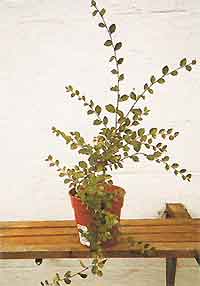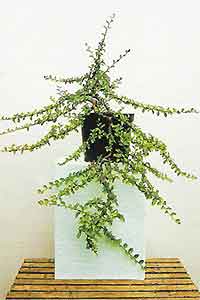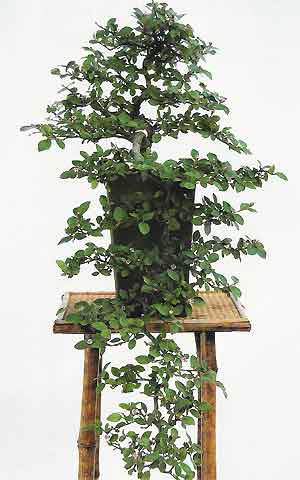Bonsai Trees
Case Histories
Cotoneaster - (cotoneaster horizontalis)
Cotoneaster Bonsai Style: Cascade

This natural seedling was found growing at the top of my garden, under an apple tree. It was just over a year old and had a forked trunk which was heavily curved. Being early summer, I dug it up carefully so as not to damage the small root system and planted it in a flower pot. I was pleased with my most convenient find and left the tree to establish for the rest of the year, feeding well.
The next year I lightly root pruned the tree and a larger flower pot was selected, to provide extra room for the roots to spread. I did not prune the branches so that the strong growth would help to thicken up the thin trunk and I fed heavily.
Later in the season, as the cotoneaster was becoming rather overgrown, some styling became necessary and the natural curves seemed to lend themselves to the tree becoming a cascade style.
Cotoneaster Bonsai History: Training

The longest shoot was duly wired as the main trunk and the shorter trunk was chosen to become the apex of the tree. I was pleased with the resulting shape and the tree remained in the same flower pot for a further year after root pruning that spring. Some long shoots were trimmed to balance the energy flow throughout the tree.
One year later and the cotoneaster was potted on into a slightly larger flower pot. Several branches were wired into position, but not pruned. The trunk still needed to become thicker and I let the tree grow freely in an effort to achieve this. I also wired the main trunk further, which was now cascading well below the bottom of the flower pot.
At the end of the season I heavily pruned the crown, which typical of bonsai trained in the cascade style, had become the most vigorous part. By removing so much growth from the top, more sap could be channeled into the bottom of the main trunk, which had not grown much that year.
The following season the growth was well balanced. Branches began to extend all over the trunk and when long enough, these were wired into place. That spring, the cotoneaster flowered sparsely, but enough to show what a pleasing feature of the tree this would become.

Being so tiny, the flowers were in perfect proportion and small red berries followed that autumn, together with good, fiery autumnal foliage. I took advantage of the cotoneaster being a deciduous variety and studied the trunk that winter without foliage. It was becoming quite thick and I removed some unnecessary shoots to show off the good trunk line more.
After three more years in a flower pot, I found the perfect bonsai pot. Being tall and thin, the depth visually matched the shape of the tree and the soft gold/brown colour blended with the trunk. The branches were pruned hard, shortening them so that the tree became much narrower and more downward in appearance. I extensively thinned the apex and completely wired all of the branches. Much attention was given to the lowest part of the trunk and this was positioned into a gentle curve reflecting the shape of the main crown. At last a cascade cotoneaster bonsai had been created!
 This natural seedling was found growing at the top of my garden, under an apple tree. It was just over a year old and had a forked trunk which was heavily curved. Being early summer, I dug it up carefully so as not to damage the small root system and planted it in a flower pot. I was pleased with my most convenient find and left the tree to establish for the rest of the year, feeding well.
This natural seedling was found growing at the top of my garden, under an apple tree. It was just over a year old and had a forked trunk which was heavily curved. Being early summer, I dug it up carefully so as not to damage the small root system and planted it in a flower pot. I was pleased with my most convenient find and left the tree to establish for the rest of the year, feeding well. The longest shoot was duly wired as the main trunk and the shorter trunk was chosen to become the apex of the tree. I was pleased with the resulting shape and the tree remained in the same flower pot for a further year after root pruning that spring. Some long shoots were trimmed to balance the energy flow throughout the tree.
The longest shoot was duly wired as the main trunk and the shorter trunk was chosen to become the apex of the tree. I was pleased with the resulting shape and the tree remained in the same flower pot for a further year after root pruning that spring. Some long shoots were trimmed to balance the energy flow throughout the tree. Being so tiny, the flowers were in perfect proportion and small red berries followed that autumn, together with good, fiery autumnal foliage. I took advantage of the cotoneaster being a deciduous variety and studied the trunk that winter without foliage. It was becoming quite thick and I removed some unnecessary shoots to show off the good trunk line more.
Being so tiny, the flowers were in perfect proportion and small red berries followed that autumn, together with good, fiery autumnal foliage. I took advantage of the cotoneaster being a deciduous variety and studied the trunk that winter without foliage. It was becoming quite thick and I removed some unnecessary shoots to show off the good trunk line more.